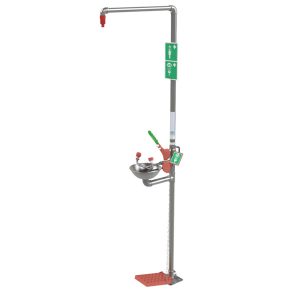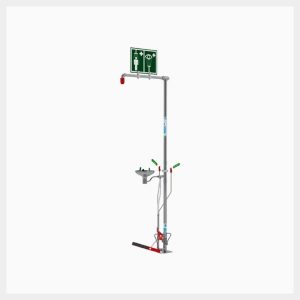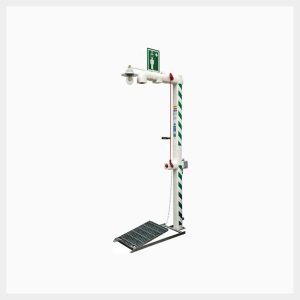Your Safety Shower May Be Complaint But is Your Water Temperature?
When the sun heats up shower pipes it can increase water temperature to over 50 degrees Centigrade. Using this water to flush skin and eyes damaged by chemical burns can cause considerable damage.
The self draining safety showers are designed to drain the water out of the shower and eyewash pipes when not in use and prevent scalding from water overheated by exposure to the sun.
The unique conical profile shower nozzle and solid spigot 316 ball valve will ensure years of trouble free use.
This style safety shower is available as available as a combination shower/eye & face wash as well as a shower with body spray for multi-directional flushing.
Features:
- Full stainless steel pipes & fittings
- Pipe wall thickness 2.3mm
- Solid spigot 316 ball valve
- Conical profile shower nozzle
- Bottom water inlet
- Self-draining design
- Complies with AS4775-2007
- Complies with ANSI Z358.1-2004
- Full 2 year warranty
Options:
- Foot control pedal for eyewash
- Scald protection valve
- Flow switch
- Compliant signage
- Audible/visual alarms
- Lighting
- Anti-slip mating
The Benefits of a Combination System
Safety shower and eyewash stations are essential to remaining compliant with Australian Standards, while also keeping your employees safe.
Safety showers and eyewash stations are essential for workplaces that may result in exposure to contaminants by providing emergency burn treatments and can even allow workers to shower at the end of their day.
Eyewash stations are used to irrigate eyes with water to flush them and keep employees safe from hazards that may enter the eyes.
Combination safety showers and eyewash stations help flush both the eyes and the body at once, making it a highly protective option. These combination units are also useful in any situation where a worker can’t follow directions due to pain or shock.
Remain Compliant
Safety showers and eyewash stations should comply with the Australian Standard AS4775.
This means safety showers and eyewash stations must comply with the following:
- The safety shower must have a minimum flow rate of 75.5L/min for at least 15 minutes, and this also applies to eyewash combination units.
- Plumbed eyewash stations must flow for 11/4L/min for 15 minutes.
- In the case of a shower and eyewash unit combined, both elements of the unit must have the appropriate flow rate, even when working simultaneously.
- Both units must use tepid water.
- The safety shower must be easy to locate and readily accessible without any hindrances.
- Safety shower must be able to be accessed within 10-15 seconds without any obstructions.
- The eyewash design must allow for the eyelids to be held open while the eyes are being flushed.
- Nozzles on the eyewashes are protected from airborne contaminants.
- Safety showers must be placed near any hazards.
- Equipment must be tested on a weekly basis and inspected for compliance annually.
Combination Unit Placement
When it comes to correctly place your safety shower and eyewash station unit, there are a few things to consider.
The shower must be accessible: the shower must be positioned on the same level as the hazard, with the path taken by affected employees free of obstructions. This is done to ensure that people can access the safety equipment before harm occurs due to chemical exposure.
The shower must be highly visible: staff must be able to quickly identify the location of the equipment after being exposed to hazardous chemicals, if not they may not make it to the shower in time to avoid serious harm.
Employees must be able to reach the shower in 10-15 seconds: In order to fight the contamination, the injured worker must be able to make it to the station within 10-15 seconds. To do this correctly, risk assessment is important.
If you need help understanding the risks within your workplace, and where the safety shower should be placed, Spill Station offers comprehensive audits. These audits are conducted by Spill Station’s experts and are designed to keep you compliant, and your workplace safe.
Spill Station’s Offerings
Initial Safety Shower Test: this is a service to aid in the inspection, testing and maintenance of the shower. This is a 38-point annual compliance inspection, and includes the testing of flow rates, checking of water temperature, positioning and installing the shower and auditing the location of the shower.
Floor Mounted Drench Shower: this is suitable for hot climates and allows for standing water to drain away from the standpipe to make sure the delivery of tepid water is constant. These drench showers are also available in insulated options for extreme temperatures.
Outdoor Safety Shower and Eyewash: this unit is available insulated and in stainless steel to combat high heat and high cold temperatures. This unit is for a non-compliant first flush of contaminants before the user gets further help.










